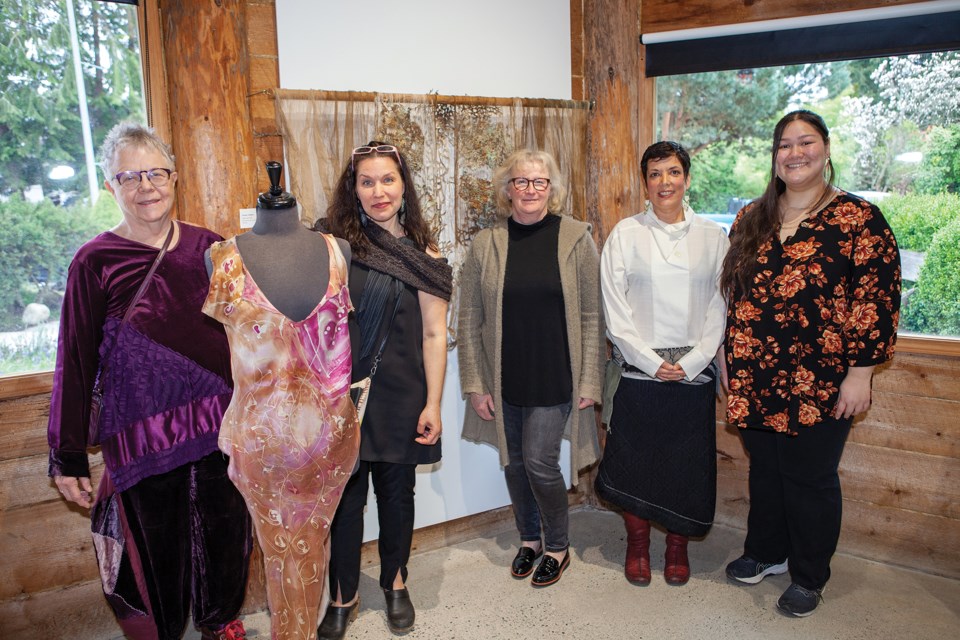Works by five textile artists unveiled last week in Sechelt provide a beguiling rebuke to frenzied and short-lived cycles of commercial fashion.
The Slow Fashion + Climate Action exhibition opened at the Sunshine Coast Arts Centre with a crowded public reception on April 21. The show, presented in collaboration with the FibreWorks Society of Madeira Park, features garments and other textiles created by Amber Freidman, Ann Harmer, Catherine Nicholls, Natalie Grambow and Sandy Buck.
“Seeing the quality that up-cycled and repurposed materials can reach has been insane for me,” said Emily Picard, the Arts Council’s design and communications assistant — and curator of the show. Picard formerly participated in a program that paired Sunshine Coast textile artists with young designers to explore techniques that breathe new life into old clothes.
“We saw little examples of tips and tricks in the class,” added Picard, “and here [in the exhibition] you can see how small things add up, and the level of style that it adds up to.”
Picard worked alongside FibreWorks executive director Alexis Bach to interpret and display the featured pieces.
For contributor Catherine Nicholls, the reuse of woven materials is charged with historical power. She uses traditional mending techniques — known as Boro, Kantha and Sashiko — to combine layers of reclaimed fabrics.
“When you’re an 18th century fisherman, you don’t have access to a change of clothes or to a Helly Hansen outlet,” said Nicholls. “You come home with a hole in your elbow and you need it mended. Over the years, through such practical mending, the things that women do became artwork and it’s just evolved. You find a way to do it artfully, using stitches used over generations, which I really like to honour.”
Nicholls once wore the svelte violet dress that she contributed to the exhibition. Like other examples of her work on display, Nicholls augmented the dress with ruffles and enhanced stitching. Although Nicholls originally made many of her own clothes, she gradually began to patronize commercial outlets. After her move to the Sunshine Coast, she realized the deleterious environmental effects of disposable couture, including waste and the sorry condition of factory workers.
“So I made a conscious decision to never buy retail clothes again,” Nicholls said. “Now I work with the fabrics, the colour, the texture, the sheen, the drape. It opened up a whole new world for me where I can be more creative in what I choose and create designs of my own, which I hope are wearable and at the same time are nice to look at.”
Designer Sandy Buck, who began sewing clothes at the age of eight, believes that fabric embodies spirit. She worked previously at a fabric store, and has created costumes for a range of theatre projects.
At the exhibition opening, Buck wore a pattern-sewn blouse and a prized scarf by Japanese designer Issey Miyake. The costly, commercially-made scarf was so treasured by Buck that she rarely took it out of her closet. A renewed dedication to handmade and recycled fashion made her rethink those reservations.
“I love it, but it needs to move on,” she announced, handing pairs of scissors to bystanders. She slid the diaphanous scarf from her shoulders. The crowd gasped. “If anyone wants to come forward and cut a piece for themselves, you are welcome. It needs to grow. Those that choose can turn it into something new, something beautiful.”
The show also includes works by artists Amber Friedman and Natalie Grambow. Powell River-based Friedman stencils thickened dyes and oxides onto clothing dyed with plant-derived pigments. Grambow, who teaches in the Fashion department of Kwantlen University, is showcasing textile assemblages that bear the imprint of foraged flora.
Slow Fashion + Climate Action remains at the Sunshine Coast Arts Centre in Sechelt until May 13.



